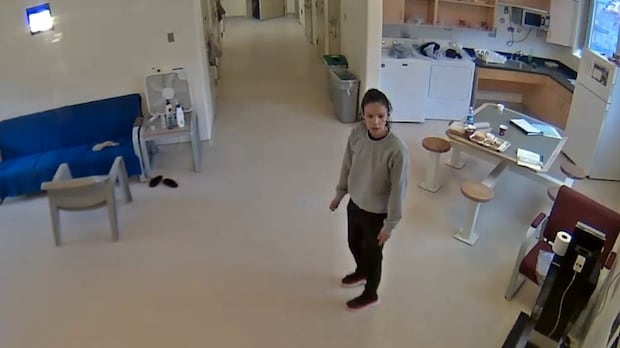The woman pauses for a second. She lifts the sleeve of her sweatshirt to wipe the pepper spray from her face, then folds her hands behind her back and drops to her knees, clearly resigned to the handcuffs that are quickly snapped on her wrists.So it ended, an incident lasting 18 minutes during which an agitated Serena Tobaccojuice, currently one of Canada’s longest-serving female inmates, blocked the door of her Nova Scotia prison unit, grasping tweezers bent into a weapon, threatening and preventing two guards from leaving.How Tobaccojuice, a Cree woman from Saskatchewan, ended up facing charges in Truro, N.S., 3,000 kilometres from her home province, is now at the heart of an extraordinary argument in the criminal case she faces involving the two correctional officers. Her defence lawyer is asking a judge to grant the convicted killer, who has a record of multiple prison hostage-takings, the most lenient sentence available for an adult in Canada: an absolute discharge.“It’s an acknowledgment by this court that for the first time in this woman’s life, consideration is actually being given to her history for the first time, and that for the first time, she’s going to be given mercy, essentially,” her lawyer, Jeremiah Raining Bird, told the court in June.The incident on Oct. 26, 2022, at Nova Institution for Women, captured in video surveillance footage entered as evidence in court, ended with no injuries to the guards, who stood calmly throughout. Originally charged with two counts of hostage-taking, Tobaccojuice pleaded guilty last year to the less serious crime of unlawful confinement.The Nova Institution for Women prison in Truro, N.S., is shown on Oct. 3, 2025. (Richard Cuthbertson/CBC)This week, Nova Scotia provincial court Judge Ian Hutchison will hand down a sentence, more than three years on from the date of the offence and following a hearing that has stretched sporadically over months.It has included evidence about Tobaccojuice’s nearly three-decade-long path through the federal corrections system, often with lengthy periods in isolation, the suffering of her childhood, and in the words of one witness, the “litany of systemic failures” she has faced.She has, according to her lawyer, “never had a chance.” As a child, she witnessed terrible crimes. She was stabbed at the age of eight, the court has been told. She began drinking alcohol at seven, and was hospitalized for alcohol poisoning at 11.She was placed in foster care by child protection officials. She was called racial slurs, and told not to speak her Indigenous language, according to her lawyer. Her extended family was forced to attend residential school.The entrance to Nova Scotia provincial court in Truro, N.S., is shown on Nov. 13, 2025. (Craig Paisley/CBC)Even her name has been the subject of discussion. Long called Serena Nicotine in both the justice system and the media, she has said her correct surname is Tobaccojuice, a mix-up stemming from a police officer’s mistake when she was a youth. Tobaccojuice is the name now used in court.Her past also comprises a disturbing criminal record. She is serving a life sentence for murder in the 1997 stabbing death of 58-year-old group-home caregiver Helen Montgomery in North Battleford, Sask. Tobaccojuice was 15 at the time, as was a second teen convicted in the case.It was a crime that drew widespread attention and prompted calls to toughen the youth justice system. In 2005, the Saskatchewan government apologized to Montgomery’s family and paid them $142,500 in compensation.The murder conviction means that no matter what sentence she is handed in the Nova Scotia case, Tobaccojuice’s ultimate release from behind bars, if ever, will be up to the Parole Board of Canada.Her first decade or so in the federal prison system was punctuated by multiple convictions for hostage-takings, assaults, extortion and forcible confinement. Victims included other inmates, but also prison guards and a nurse.It’s a record that prosecutor Andy Melvin has argued must be considered, making an absolute discharge in the Nova Scotia case not in the public interest. Order needs to be maintained in Canada’s correctional system, he said, and a three-year sentence is more appropriate.There’s no doubt Tobaccojuice has “had a tragic life,” he told the court in June, “but that has to be balanced with the tragedy that she has inflicted on others.”Hostage-takingsIn some hostage-takings, Tobaccojuice has been part of a group. In others, she’s acted alone. Some victims have been injured and traumatized. One correctional guard, held for more than four hours in 2001, was threatened, burned with a cigarette and had her hair cut, according to a court decision.Demands have included phone calls, cigarettes or medications, such as Ritalin. Weapons used have ranged from a ripped pop can to a soap-filled sock, a pair of eyeglasses and glass from a smashed TV (more than once).One B.C. judge, in 2010, called the record strikingly serious. But hostage-takings among female inmates were “not uncommon,” he noted. Futile as they seem, they were perhaps the symptom of “enormous frustration and hopelessness that infects many of the long-term inmates.”Sen. Kim Pate speaks about legislation passed by the Senate about human rights for federal prisoners during a news conference in Ottawa on Dec. 11, 2024. (Adrian Wyld/The Canadian Press)According to Sen. Kim Pate, the former head of the Canadian Association of Elizabeth Fry Societies who has known Tobaccojuice since she was a teenager, the phenomenon of hostage-takings involving female inmates began about 25 years ago at the Saskatchewan Penitentiary.At the time, the men’s prison also housed maximum-security female inmates. Hostage-takings were viewed as a way to get things, she said, and she subsequently learned that, initially, some were effectively staged, with inmates agreeing to be victims. That, however, escalated.In an interview with CBC News, Tobaccojuice said she first arrived at Saskatchewan Penitentiary at the age of 18. She said she was told she was the youngest inmate in the prison.“So they put me in segregation there and they gave me a Bible,” she said. “That is all they gave me. And like, that’s how it was way back in the day. They don’t do that now.“But like, I wanted to talk to an elder, you know, something like with my own culture, and instead they gave me a Bible to read and only a Bible to read.”She said she had heard horror stories about prison and was afraid. But her murder case had garnered significant attention, she said, and she arrived with a reputation as “high profile” and “cold-hearted.” She said she wanted to be tough like the other women.According to testimony in Nova Scotia court, Tobaccojuice has spent more than half her time in the federal prison system in segregation or under some form of isolation.The longest stretch, she said, was three years under a severely restrictive segregation regime that targeted a small number of female inmates, most of them Indigenous, and which was abandoned by the Correctional Service of Canada in 2011 in the face of a court challenge.WATCH | Why the lawyer of one of Canada’s longest-serving female inmates is asking for an absolute discharge:She took 2 prison guards hostage. Her lawyer is seeking the most lenient sentence possibleOne of Canada’s longest-serving female inmates will be sentenced this week for unlawfully confining two guards at the Nova Institution women’s prison in Truro, N.S. Serena Tobaccojuice has a long history of hostage takings, but her lawyer is asking for the most lenient sentence possible. A warning to viewers, there are some distressing details in this story, including references to suicide.For a period, Tobaccojuice said, she was housed, alone, in a “cage” at a Quebec prison: “I thought I’d killed myself in that cell actually. I kept asking the staff members, am I real? Am I alive and like, do we commit suicide together? Are we stuck in purgatory?”Pate said she remembers on one visit, correctional officers placed a line of tape on the floor about 1½ metres from where Tobaccojuice was “chained.” She was told she could not cross it as the inmate was “losing her mind and she was dangerous.”“Some of the forms of isolation have been absolutely horrific,” Pate said in an interview.The Correctional Service of Canada said solitary confinement was abolished in 2019, replaced by “structured intervention units,” which include independent oversight to review the length and conditions of confinement. A statement from a spokesperson said an inmate’s “Indigenous social history” must be considered before a transfer to the unit is authorized.While an advisory panel concluded last year that the units had failed to eliminate the “experience” of segregation, others argue the new system hinders the ability of guards to hold inmates accountable for in-prison infractions.Rene Howe, the Atlantic regional president of the union that represents federal correctional officers, said guards are facing a growing number of threats and assaults. Nova Institution, he said, used to be “pretty quiet,” but there’s rising violence there, too.He wouldn’t comment on Tobaccojuice’s case specifically, but said granting an absolute discharge for an inmate convicted of confining prison guards “would have a significant impact on the prison environment with the other staff, would it not?”’Dangerous and violent behaviour’Melvin, the prosecutor in the case, told the court he has no doubt Tobaccojuice has spent too much time in segregation. But he argued there would be a “destabilizing effect” on the correctional system if word got out that an inmate could confine and threaten prison guards and receive nothing more than an absolute discharge.“How are prison guards supposed to maintain order in a penitentiary if they’re unable to address dangerous and violent behaviour within that institution itself?” he asked.Tobaccojuice said she agreed to an interview for two reasons. She said she wants correctional officials to take medical complaints from inmates more seriously, and not dismiss them as drug- or attention-seeking. She also said she wanted to dispel the notion that she is a “psychopath.”Many women in prison have mental disorders, she said, and she urged correctional officials to be patient and not chalk it up to bad behaviour. A psychiatrist diagnosed her with post-traumatic stress, according to the 2010 court decision. She was also born with fetal-alcohol syndrome.On the day three years ago that she prevented guards from leaving her unit at Nova Institution, Tobaccojuice said she was in severe pain, and felt she wasn’t receiving help. She used the tweezers to also threaten herself. She said she thought she was going to die.She had been friends with Ashley Smith and was on the same unit when the 19-year-old inmate died in 2007 from self-strangulation as prison guards looked on. She was also on a unit with Kinew James, who died of cardiac arrest in 2013.Eventual release?She has been eligible for day parole since 2018, but she has never applied. There is a sense, however, that after all these years she is finally working toward some kind of conditional release, a path on hold pending the outcome of her Nova Scotia case.In particular, she said, she hopes to be granted escorted temporary absences. She said she wants to attend Indigenous sweats and sun dances, and help with the homeless.“Heal, that’s what I want,” she said. “I want healing from being in prison this long.”She also hopes to visit the graves of relatives who died during her nearly three decades behind bars. Among them, her mother.“I’m still dealing with that pretty much on a daily basis. I miss my mother.”MORE TOP STORIES
Should one of Canadas longest-serving female inmates be granted mercy?











